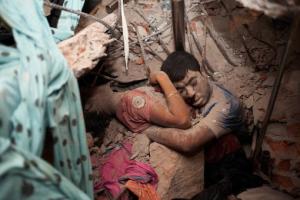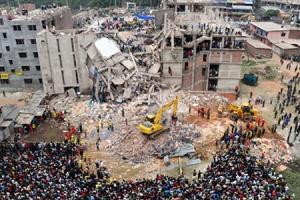Workers Set Factories Ablaze in Call for Decent Wage for Producing Globe's 'Cheap' Clothing
Common Dreams
 Low-cost labor has attracted Western brands to the Southeast Asian country and garments now account for around 75 percent of its exports, but strikes over pay and working conditions have become common. Thousands of workers at Sabrina (Cambodia) Garment Manufacturing Corp went on strike for higher pay from May 21.
Low-cost labor has attracted Western brands to the Southeast Asian country and garments now account for around 75 percent of its exports, but strikes over pay and working conditions have become common. Thousands of workers at Sabrina (Cambodia) Garment Manufacturing Corp went on strike for higher pay from May 21.
 The list of “accidents” in Bangladesh factories is long and painful. These factories are a part of the landscape of globalization that is mimicked in the factories around the world in other places that opened their doors to the garment industry’s savvy use of the new manufacturing and trade order of the 1990s. Those who died in Bangladesh are victims not only of the malfeasance of the sub-contractors, but also of 21st century globalisation.
The list of “accidents” in Bangladesh factories is long and painful. These factories are a part of the landscape of globalization that is mimicked in the factories around the world in other places that opened their doors to the garment industry’s savvy use of the new manufacturing and trade order of the 1990s. Those who died in Bangladesh are victims not only of the malfeasance of the sub-contractors, but also of 21st century globalisation.
 The latest sweatshop disaster in Bangladesh, which claimed the lives of over 200 young women, calls into question the foundations of US globalization policies since the Clinton era. It is not enough to blame the corruption of Bangladesh factory owners, nor sufficient to suggest better training and factory codes from Walmart or the Gap. It is time to ban the US sale of garments made in Bangladesh until enforceable labor codes are imposed on that country.
The latest sweatshop disaster in Bangladesh, which claimed the lives of over 200 young women, calls into question the foundations of US globalization policies since the Clinton era. It is not enough to blame the corruption of Bangladesh factory owners, nor sufficient to suggest better training and factory codes from Walmart or the Gap. It is time to ban the US sale of garments made in Bangladesh until enforceable labor codes are imposed on that country.
 The Nov. 24 blaze in Bangladesh killed 112 garment workers and increased pressure on Wal-Mart and other Western retailers to help improve factory conditions and take more direct responsibility for their suppliers. Clothing bound for Wal-Mart and Sears was found in the charred ruins. Both companies have said suppliers used the Tazreen factory without their permission and were fired.
The Nov. 24 blaze in Bangladesh killed 112 garment workers and increased pressure on Wal-Mart and other Western retailers to help improve factory conditions and take more direct responsibility for their suppliers. Clothing bound for Wal-Mart and Sears was found in the charred ruins. Both companies have said suppliers used the Tazreen factory without their permission and were fired.
Spread the word